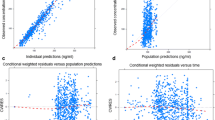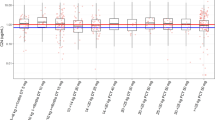Abstract
The objective of this analysis was to characterize the time course of selected pharmacodynamic (PD) markers of tesamorelin: growth hormone (GH) and insulin-like growth factor (IGF-1) concentrations in HIV-infected patients and healthy volunteers. A total of 41 subjects in Phase I trials receiving subcutaneous daily doses of 1 or 2 mg of tesamorelin during 14 consecutive days were included in this analysis. A previous pharmacokinetic (PK) model of tesamorelin was used as the input function for the PD model of GH. Tesamorelin was hypothesized to stimulate the secretion of GH in an “episodic” manner, i.e., for a finite duration of time. The resulting PK/PD model of GH was used to describe the time course of IGF-1. The effect of age, body weight, body mass index, sex, race, and health status on the model parameters was evaluated. The model was qualified using predictive checks and non-parametric bootstrap. Within the range of the values evaluated no covariates were significantly associated with GH or IGF-1 model parameters. Model evaluation procedures indicated accurate prediction of the selected pharmacodynamic markers. The time course of GH and IGF-1 concentrations following multiple doses of tesamorelin were well predicted by the sequential PK/PD model developed using Phase I data.








Similar content being viewed by others
References
Falutz J, Mamputu JC, Potvin D, Moyle G, Soulban G, Loughrey H, Marsolais C, Turner R, Grinspoon S (2010) Effects of tesamorelin (TH9507), a growth hormone-releasing factor analog, in human immunodeficiency virus-infected patients with excess abdominal fat: a pooled analysis of two multicenter, double-blind placebo controlled phase 3 trials with safety extension data. J Clin Endocrinol Metab 95:4291–4304
Stanley TL, Falutz J, Marsolais C, Morin J, Soulban G, Mamputu JC, Assaad H, Turner R, Grinspoon SK (2012) Reduction in visceral adiposity is associated with an improved metabolic profile in HIV-infected patients receiving tesamorelin. Clin Infect Dis 54:1642–1651
Theratechnologies Inc. Egrifta® (tesamorelin for injection): US prescribing information [online]. http://www.accessdata.fda.gov/drugsatfda_docs/label/2010/022505s000lbl.pdf. Accessed 27 Mar 2015
Center for Drug Evaluation and Research. Clinical pharmacology and biopharmaceutics review(s) [online]. http://www.accessdata.fda.gov/drugsatfda_docs/nda/2010/022505Orig1s000ClinPharmR.pdf. Accessed 27 Mar 2015
Stanley TL, Chen CY, Branch KL, Makimura H, Grinspoon SK (2011) Effects of a growth hormone-releasing hormone analog on endogenous GH pulsatility and insulin sensitivity in healthy men. J Clin Endocrinol Metab 96:150–158
González-Sales M, Barrière O, Tremblay PO, Nekka F, Mamputu JC, Boudreault S, Tanguay M (2015) Population pharmacokinetic analysis of tesamorelin in HIV-infected patients and healthy subjects. Clin Pharmacokinet 54:285–294
Dhillon S (2011) Tesamorelin. A review of its use in the management of HIV-associated lipodystrophy drugs 71:1071–1091
Dayneka NL, Garg V, Jusko WJ (1993) Comparison of four basic models of indirect pharmacodynamics response. J Pharmacokinet Biopharm 24:457–478
Gobburu JVS, Agerso H, Jusko WJ, Ynddal L (1999) Pharmacokinetic-pharmacodynamic modelin of ipamorelin, a growth hormone release peptide, in human volunteers. Pharm Res 16:1412–1416
Giustina A, Veldhuis JD (1998) Pathophysiology of the neuroregulation of growth hormone secretion in experimental animals and the human. Endocr Rev 19:717–797
Savic RM, Karlsson MO (2007) Diagnosing model diagnostics. Clin Pharmacol Ther 82:17–20
Mandema JW, Verotta D, Sheiner LB (1992) Building population pharmacokinetic-pharmacodynamic models. I. Models for covariate effects. J Pharmacokinet Biophar 20:511–528
Brendel K, Comets E, Laffont C, Laveille C, Mentré F (2006) Metrics for external model evaluation with an application to the population pharmacokinetics of gliclazide. Pharm Res 23:2036–2049
Efron B, Tibshirani R (1993) An introduction to the bootstrap. Chapman & Hall, London
Friend K, Iranmanesh A, Veldhuis JD (1996) the orderliness of the growth hormone (gh) release process and the mean mass of gh secreted per burst are highly conserved in individual men on successive days. J Clin Endocrinol Metab 81:3746–3753
Veldhuis JD, Carlson ML, Johnson ML (1987) The pituitary gland secretes in bursts: appraising the nature of glandular secretory impulses by simultaneous multiple-parameter deconvolution of plasma hormone concentrations. Proc Natl Acad Sci 84:7686–7690
Ferdinandi ES, Brazeau P, High K, Procter B, Fennell S, Dubreuil P (2007) Non-clinical pharmacology and safety evaluation of TH9507, a human growth hormone-releasing factor analogue. Basic Clin Pharmacol Toxicol 100:49–58
Zirilli L, Orlando G, Carli F, Madeo B, Cocchi S, Diazzi C, Carani C, Guaraldi G, Rochira V (2012) GH response to GHRH plus arginine is impaired in lipoatrophic women with human immunodeficiency virus compared with controls. Eur J Endocrinol 166:415–424
Zeinalizadeh M, Habibi Z, Fernandez-Miranda JC, Gardner PA, Hodak SP, Challinor SM (2015) Discordance between growth hormone and insulin-like growth factor-1 after pituitary surgery for acromegaly: a stepwise approach and management. Pituitary 18:48–59
Acknowledgments
This work was supported by Mitacs ELEVATE, in partnership with inVentiv Health, NSERC-Industrial Chair in Pharmacometrics and FRQNT. The authors would like to thank the reviewers of this manuscript for their careful reading and suggestions.
Conflict of interest
Jean-Claude Mamputu is an employee of Theratechnologies Inc., which supported this study. Other authors declare no conflict of interest.
Author information
Authors and Affiliations
Corresponding author
Rights and permissions
About this article
Cite this article
González-Sales, M., Barrière, O., Tremblay, P.O. et al. Population pharmacokinetic and pharmacodynamic analysis of tesamorelin in HIV-infected patients and healthy subjects. J Pharmacokinet Pharmacodyn 42, 287–299 (2015). https://doi.org/10.1007/s10928-015-9416-2
Received:
Accepted:
Published:
Issue Date:
DOI: https://doi.org/10.1007/s10928-015-9416-2




